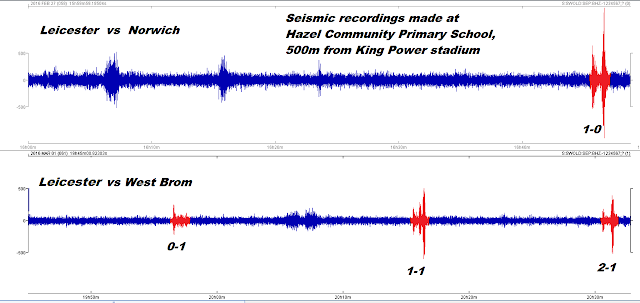
Leicester City Football Club has been making a big impact on the Premier League this season, and their success is sending shockwaves, quite literally, through the city of Leicester.
Geology students at the University of Leicester have been monitoring large seismic signals detected by earthquake monitoring equipment installed at Hazel Community Primary School near the King Power Stadium.
The students discovered that the equipment was actually measuring small earthquakes produced by the sudden energy release by the elated Leicester fans when their team scored a goal at home matches.
Richard Hoyle, a first year student from Leeds studying geological science at the University of Leicester said: “A few days after we installed the equipment at the school and were analysing data collected, we noticed large peaks on the seismogram during football matches being held in the LCFC stadium nearby.
“A closer look showed us there was a strong correlation between the exact time Leicester scored at home and the occurrence of the large seismic signals. We concluded that our equipment was actually measuring small earthquakes produced by the sudden energy release by the cheering Leicester fans celebrating at the moment a goal was scored.”
Working with Paul Denton, a seismologist working for the British Geological Survey, the project, involving 20 students studying Geology and Geophysics at the University of Leicester, started off as an outreach project.
The students installed earthquake monitoring equipment at Hazel Community Primary School enabling them to detect, record and calculate the magnitudes of seismic signals coming from earthquakes around the world.
The equipment works in unison with a similar system in the basement of the University’s Department of Geology Bennett Building and another recently installed set in the New Walk Museum.
By measuring small earthquakes using this equipment, the students are then able to calibrate the calculation for the Leicester-goal-quakes.
During the match between Leicester and West Bromwich Albion on Tuesday 1 March, the equipment detected strong seismic signals during the first half when Leicester scored a goal which measured a magnitude 0.1. A much smaller signal was detected when the opposition scored – probably due to the smaller visiting crowds for an away game.
Richard said of the game against Norwich: “Our biggest signal detected so far came last Saturday (27 February) when Leicester scored the only goal in the match in the 89th minute and this registered a magnitude 0.3 -clearly the fans were very tense!
“This project gives us a fantastic opportunity to conduct a novel investigation for the remainder of the football season while also further engaging the school children while their home team is doing so well in the football tables.
“Besides naturally occurring earthquakes, we are now curious to discover which Leicester City footballer will generate the biggest seismic signal. Our money is on Vardy.”
Dr Stewart Fishwick, Senior Lecturer in Geophysics, University’s Department of Geology, said: “Having our equipment installed within the local primary school has given our students an excellent opportunity to engage with young minds and inspire them to take an interest in practical applications of Earth Sciences.
“Several of the students in our group are due to hold demonstration classes with years 5 & 6 to give them a better understanding of earthquakes and the way seismic waves move through the earth.”
Gillian Blatherwick, Head Teacher at Hazel Community Primary School, said: “We’re delighted at the opportunity for pupils to work with students from the University of Leicester as this is a fantastic opportunity for Hazel pupils to be inspired by first-hand experience of practical science in a real life context.”

Note: The above post is reprinted from materials provided by University of Leicester.










